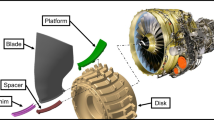Abstract
High-cycle fatigue (HCF) has been identified as one of the primary causes of gas turbine engine failure. The modal characteristics and endurance strength of a 5 MW gas turbine engine blade developed by Doosan Heavy Industries & Construction Co., Ltd. in HCF fracture were verified through analysis and tests to determine the reliability of the compressor blade. A compressor blade design procedure that considers HCF life was performed in the following order: airfoil and blade profile design, modal analysis, stress distribution test, stress endurance limit test, and fatigue life verification. This study analyzed the Campbell diagram and estimated resonance risk on the basis of the natural frequency analysis and modal test of the compressor blade to guarantee safe and operational reliability. In addition, the maximum stress point of the compressor blade was determined through stress distribution analysis and test. The bonding point of the strain gage was determined by using fatigue test. Stress endurance limit test was performed based on the results of these tests. This research compared and verified the modal characteristics and endurance strengths of the compressor blades to prevent HCF fracture, which is among the major causes of gas turbine engine damage. A fatigue life design procedure of compressor blades was established. The 5 MW class gas turbine compressor blade is well designed in terms of resonance stability and fatigue endurance limit.
Similar content being viewed by others
References
A. S. Lee, Y. C. Kim and D. W. Lee, Evaluation of blades vibration reliabilities of KGT-74 small gas turbine, Trans. of the KSNVE, 14(5) (2004) 410–415.
J. S. Rao, Turbine blade life estimation, Alpha Science International Ltd. (2000).
D. E. Thomson and T. G. Griffin, The national turbine engine high cycle fatigue program, IGTI Global Gas Turbine News, 39(1) (1999) 14–17.
A. S. Lee, Vibration design of the gas turbine engine blade, Journal. of the KSME, 38(8) (1998) 55–58.
P. K. Wright, M. Jain and D. Cameron, High cycle fatigue in a single crystal superalloy: time dependence at elevated temperature, Proc. of the 10th International Symposium on Superalloys, TMS (2004).
W. Tarar, O. Scott-Emuakpor and M. H. Herman Shen, A new finite element for gas turbine engine fatigue life prediction, Proc. of ASME Turbo Expo, GT2007-27427, Montreal, Canada (2007).
C. W. Cho and K. H. Yang, An experimental study on vibration mode of steam turbine blade, Proceeding of KSME Symposium (2002) 2417–2422.
Guide Technical Material 108.022.104-77, The Standards for Vibration Reliability of Axial Compressor Rotor Blades, written in Russian (1977).
K. K. Kim and Y. S. Lee, Modal characteristics according to the tip shape and assembly condition of the turbine blade, Journal of Mechanical Science and Technology, accepted. (2013).
ANSYS Theory Reference, ANSYS Corporation (2011).
T. Misek, A. Tetiva, L. Prchlik and K. Duchek, Prediction of high cycle fatigue life of steam turbine blading based on unsteady cfd and fem forced response calculation. Proc. of ASME Turbo Expo, GT2007-278, Montreal, Canada (2007).
J. Liu, J. Gao and Tieyu Gao, Forced convection heat transfer of steam in a square ribbed channel, Journal of Mechanical Science and Technology, 26(4) (2012) 1291–1298.
Y. S. Choi and K. H. Lee, Investigation of blade failure in a gas turbine, Journal of Mechanical Science and Technology, 24(10) (2010) 1969–1974.
M. P. Sigh, J. J. Vargo, D. M. Schiffer and J. D. Dello, Safe diagram — a design and reliability tool for turbine blading, Proc. of the Seventeenth Turbomachinery Symposium (1988) 93–102.
A. N. Arkhipov, A. V. Pipopulo and L. V. Putchkov, Design tuning of high aspect ratio shrouded turbine blades, Proc. of ASME Turbo Expo, GT2008-50607, Berlin, Germany (2008).
A. V. Srinivasan, Flutter and resonant vibration characteristics of engine blades, Trans. of the ASME. Journal of Engineering for Gas Turbine and Power, 119(4) (1997) 742–775.
E. Poursaeidi, M. Aieneravaie and M. R. Mohammadi, Failure analysis of a second stage blade in a gas turbine engine, Journal of Sound and Vibration, 282 (2005) 1065–1083.
O. Scott-Emuakpor, M. H. Herman Shen, C. Cross, J. Calcaterra and T. George, Development of an improved high cycle fatigue criterion, Proc. of ASME Turbo Expo, GT2004-53851, Vienna, Austria (2004).
T. J. George, M. H. Herman Shen, T. Nicholas and C. J. Cross, A new multiaxial fatigue testing method for variableamplitude loading and stress ratio, Proc. of ASME Turbo Expo, GT2003-38512, Atlanta, Georgia, USA (2003).
C. M. Sonsino, Course of sn curves especially in the high-cycle fatigue regime with regard to component design and safety, International Journal of Fatigue, 29(12) (2007) 2246–2258.
Author information
Authors and Affiliations
Corresponding author
Additional information
Recommended by Associate Editor Chang-Wan Kim
Kyungkook Kim received a B.S. degree in Mechanical Engineering from Korea Aerospace University, Korea, in 2000. He received a master’s degree in Mechanical Design Engineering at Chungnam National University, Korea. He is currently working in Doosan Heavy Industries & Construction as a senior research engineer. His research interests include gas turbine design.
Young-Shin Lee received a B.S. degree in Mechanical Engineering from Yonsei University, Korea, in 1972. He received a master’s degree and Ph.D. in Mechanical Engineering from Yonsei University, Korea, in 1974 and 1980, respectively. He is currently a professor of the Department of Mechanical Design Engineering at Chungnam National University, Korea. Professor Lee’s research interests are in the area of impact mechanics, optimal design, biomechanical analysis, and shell structure analysis.
Rights and permissions
About this article
Cite this article
Kim, K., Lee, Y.S. Modal characteristics and fatigue strength of compressor blades. J Mech Sci Technol 28, 1421–1429 (2014). https://doi.org/10.1007/s12206-014-0129-z
Received:
Revised:
Accepted:
Published:
Issue Date:
DOI: https://doi.org/10.1007/s12206-014-0129-z




